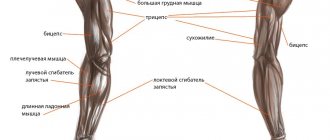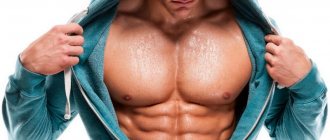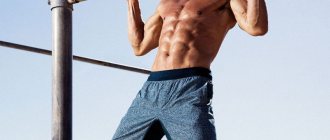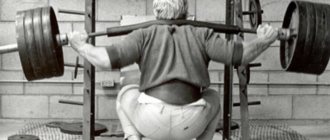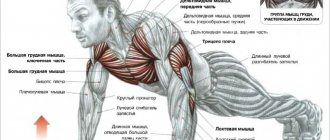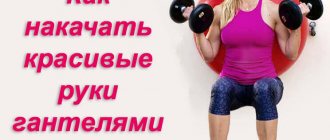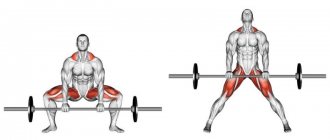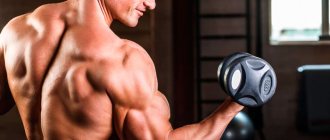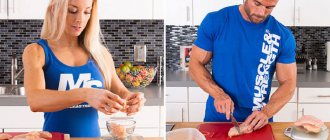Find out how to pump up your pectoral muscles with dumbbells! Everything to create really big and strong breasts: effective training, advice on nutrition and sports supplements from a professional!
There is no secret to how to pump up your chest muscles with dumbbells from all sides. A professional trainer will show you how to create great pectoral muscles - in the gym, in the kitchen and with the help of sports nutrition.
Why dumbbells? This is a universal sports equipment available to men and women in any conditions. Unfortunately, much of the equipment in modern gyms is redundant and can interfere with the requirements of a balanced exercise regimen. It’s hard to say what the reason is – the difficulty of access, the high price of equipment or the incompetent selection of simulators. As a result, the quality of exercise performance decreases.
The simulator needs to be adjusted to suit you every lesson, you need to get used to the technique of working with a barbell, and good old dumbbells will never let you down! If you know how to pump up your pectoral muscles with dumbbells, you won’t want to change your training program for a long time.
How to pump up your chest with dumbbells - basic training
Dumbbell Bench Press
- 4 sets of 12 reps
- Body part: Chest Equipment: Dumbbells
Incline Dumbbell Press
- 4 sets of 12 reps
- Body part: Chest Equipment: Dumbbells
Lifting hands with dumbbells while lying down
- 4 sets of 12 reps
- Body part: Chest Equipment: Dumbbells
Pullover with dumbbell
- 4 sets of 12 reps
- Body part: Chest Equipment: Dumbbells
Add to Calendar * Add to My Workouts * Print Workout
* — The service is in beta testing
It is recommended to perform this chest training program 2 times a week, dividing the workouts by chest sections: separately for the top, separately for the middle and bottom of the pectoral muscles. The upper part of the chest muscles is more difficult to develop, so it is important to pay more attention to it and train it on a separate day. For example, you devote Monday to the top and center of the chest, and Thursday to the lower and middle parts. The training duration will be no more than 40 minutes.
Now let's move on to an analysis of each exercise and additional training options.
Basic principles of training
- First of all, you must develop a certain routine. Focus on training your pectoral muscles 2 days a week.
- Don't focus on one area, add variety. Combine chest exercises with back exercises. These trainings go well together and will help you make your body more perfect.
- Work with an appropriate weight. You can determine whether the dumbbell weight is right for you in this way - hold it at chest level with your arm outstretched, and if you feel comfortable, then this is your weight. For those who have just started training, I advise you to start with 5-7 kg.
- Don't overexert yourself and don't rush. Try to do all your efforts while exhaling and do not forget to do the exercises smoothly and slowly. At the initial stage, do 1 set of 12-15 repetitions. Over time, you can add 1 more approach.
- If you are interested in the question of whether it is possible to “make” ideal muscles with training alone, the answer is that it will be a waste of time. Add foods containing fiber and complex carbohydrates to your diet. Protein will also not be superfluous. Well, let the old song about the dangers of fatty foods and the need to live without fast food and food in bags (chips, crackers, nuts, etc.) always ring in your ears.
Exercises with dumbbells for chest muscles
You've probably noticed that most bodybuilders' attention is focused on the effective bench press. Although the bench press is one of the most common exercises in strength training, it is debatable whether it is considered the best movement for the chest. Instead of the classic bench press, it is better to use a varied load on the chest muscles, targeting different parts of it.
The dumbbell bench press additionally engages the core stabilizer muscles and loads the arms more intensely.
Dumbbell Bench Press
Make sure the dumbbells are at the sides of your chest, your shoulders and forearms are bent at right angles, and you have full control of the exercise. At the extreme point of the movement, the arms should be slightly bent at the elbows.
It is better to increase the load without cheating, since it reduces the effect of the workout. Tighten your muscles and then lower the weight half as fast as you lifted it. Pause at the bottom of the lift before quickly lifting the weight.
Additionally, it is advisable to include in the complex a variety of dumbbell presses lying on an inclined bench upside down and dumbbell presses lying on an inclined bench. These exercises will create additional impact on the upper and lower chest.
Incline Dumbbell Press
Incline dumbbell press upside down
The best additional exercise for the chest is rightfully the lying dumbbell fly, in slang “fly” or dumbbell fly. Due to the different angles of the bench, this exercise can pump up all areas of the pectoral muscles. By working even with light weights after the main series, you will quickly notice progress and new feelings of strength.
Reduction of hands with dumbbells while lying down (“Fly”). This exercise is also important in pumping up the chest and can be performed on both a horizontal and an inclined bench.
Dumbbell curls lying on an incline bench
Correctly performed technique allows you to simultaneously load the chest and stretch it in the negative phase of the exercise.
The arms should move in a wide arc until the pectoral muscles are fully stretched, but not below shoulder level, so as not to injure the front part of the shoulder.
As in the previous version of the movement, you can perform dumbbell flyes either lying at an angle of 30-45 degrees or upside down.
Lifting hands with dumbbells while lying down
Pullover. This exercise is also an excellent final movement for the main part of the workout due to its characteristics similar to the fly.
Pullover with dumbbell
Your arms should be bent at the elbows throughout the exercise and move in a wide arc until the pectoral muscles are fully stretched, but not below shoulder level, so as not to injure the front part of the deltoids. Return to the starting position along the same path.
Principles of building pectoral muscles
The pectoral muscles are large muscles that are located above the diaphragm.
This is a large muscle, the training of which requires a lot of energy and calories. Consists of two parts:
- The main pectoralis, or large muscle , is attached to the shoulder and extends all the way to the sternum. This part of the chest provides the main volume and beautiful shape, and also provides the function of the forearms, promoting its rotation and flexion;
- The pectoralis minor, or smaller chest muscle , is much smaller than the large one, and plays a supporting role for the main one and has the shape of a triangle.
In order to pump up this part of the body, various press options are used using the hands and forearms in different positions of the body: horizontally and with slopes.
When working on the pectoral muscles, follow these principles:
- Take a break between exercises of 50-65 hours. Rest plays an equally important role in muscle building, so do not overload yourself with training. If you ignore this rule and exercise too often, the regeneration process will slow down and muscle building will proceed very slowly or stop altogether;
- Do one workout every 3-4 days;
- Follow a special diet;
- Take a 4-5 minute break between sets. Effective growth and protein production, as well as restoration of damaged tissue, takes time;
- Perform all exercises slowly and thoughtfully, without making sudden movements;
- When working on your muscles, keep them tense, this will increase the load on them;
- Don't focus on just one muscle group. Also work on your back and arms. Otherwise, you will have poor posture and a crooked back;
- Do not straighten your arms during approaches - keep them bent. This way you will maintain muscle tension and tone;
- Raise the dumbbells with both hands at the same time and to the same level, evenly distributing the weight;
- The chest muscles are quite large, so training should be intense, and the weight of the dumbbells should be large. Otherwise, the effect will be little noticeable;
- Start your workout with light weights to warm up your muscles and tone them. This will help avoid injuries and sprains;
- Perform the exercises in several approaches 10-15 times;
- Focus not on the number of repetitions, but on the quality;
- The higher you raise your arms, the better the muscles are worked;
- As the weight increases, reduce the number of repetitions;
- Pay special attention to exercises on a bench at an angle of 30-40 degrees - perform them several approaches more than other exercises;
- Give preference to dumbbells that can be disassembled - this way you can control the weight, constantly increasing it;
- The weight of one dumbbell should be on average 30-40 kg;
- If you are a beginner, use the help of a partner who will bring you dumbbells;
- If you don’t have a special bench or exercise machine in your arsenal, use stools on which you place pillows for comfort;
- Do arm extensions as slowly as possible;
- Chest workouts should be preceded by exercises that strengthen the deltoids and triceps.
How to pump up your upper chest with dumbbells
To properly pump up your chest – and it doesn’t matter whether you use dumbbells or a barbell – you must realize that the division of the chest muscles into upper, middle and lower parts is quite arbitrary. In fact, the pectoral muscle group consists of just one muscle with two parts: the sternocostal muscle and the clavicular muscle.
The chest is a large muscle group, and it is recommended to set aside a separate day for training it. For example, you can train it first, combining it with working on small muscle groups, like biceps or triceps. The combination of chest and back training with supersets in one complex is also popular.
In addition to the basic one, we offer training to work the lower part of the pectoral muscles.
Lower pectoral muscle training
Incline Dumbbell Press
- 4 sets of 8-12 reps
- Body part: Chest Equipment: Dumbbells
Dumbbell flyes on a negative incline bench
- 4 sets of 8-12 reps
- Body part: Chest Equipment: Dumbbells
Pullover dumbbells on bench
- 4 sets of 8-12 reps
- Body part: Chest Equipment: Dumbbells
Add to Calendar * Add to My Workouts * Print Workout
* — The service is in beta testing
Train as hard as you can and remember to rest and recover: get at least 8 hours of sleep.
Chest program with dumbbells
DAY 1 (bottom)
DAY 2 (top and center)
DAY 1 (bottom)
DAY 1 (bottom)
DAY 2 (top and center)
Reduction of dumbbells on a bench with a negative incline
- 4 sets of 12 reps
- Body part: Chest Equipment: Dumbbells
Pullover with dumbbell
- 4 sets of 12 reps
- Body part: Chest Equipment: Dumbbells
Incline dumbbell press upside down
- 4 sets of 12 reps
- Body part: Chest Equipment: Dumbbells
Dumbbell Bench Press
- 3 sets of 10 reps
- Body part: Chest Equipment: Dumbbells
Incline Dumbbell Press with Neutral Grip
- 3 sets of 10 reps
- Body part: Chest Equipment: Dumbbells
Lifting hands with dumbbells while lying down
- 3 sets of 10 reps
- Body part: Chest Equipment: Dumbbells
Reduction of dumbbells on a bench with a negative incline
- 3 sets of 10 reps
- Body part: Chest Equipment: Dumbbells
Dumbbell abductions lying down
- 3 sets of 10 reps
- Body part: Chest Equipment: Dumbbells
Finish off your workout with a series of stretches that cover your entire body and target your shoulders and chest muscles to ensure that your chest-pumping workout produces really good results.
Tips : The exercises can be swapped from time to time and the workout can begin not with the dumbbell press, but with the hands together. Pullover can be done not only with dumbbells, but also in a block or in a simulator, if there is one in the gym.
Lifehack . For home workouts with dumbbells, we recommend purchasing a Sport Elit press and press bench, which has a straight and negative inclination angle. It is a universal exercise machine, as it can be used to train the abdominal muscles at an angle or as a horizontal surface for exercises with dumbbells.
While working out on this simulator, you can lift your legs or torso, work with your abdominal muscles, do various lifts with dumbbells, and train your long back muscles.
Post-workout chest stretching exercises
It is important to regularly stretch the pectoral muscles as they often lack elasticity, causing the shoulders to shift forward. Not only does this cause poor posture, but it also causes damage to the upper spine as the back rounds.
The following 7 exercises will help you stretch quickly.
Stretch by moving your elbows back. Stand up straight, move your arms back and place your palms on your lower back. Start bringing your elbow joints towards each other.
Dynamic stretching. Stand up straight, straighten your arms in front of you and clasp your palms together. Quickly move your arms back and forth with maximum amplitude.
Stretching using a fitball. Get on all fours and place your left hand in a bent position on the fitball, with your right hand resting on the floor. Start pushing your body down, stretching your pectoral muscle. Repeat the exercise on the other side.
Or, an alternative wall technique: Press one hand against the wall at chest level, elbow slightly bent. Turn your body and chin in the opposite direction so that you feel the maximum stretch in your chest muscles.
One arm stretch. Stand in a doorway or in front of a squat rack. Place your left arm at a 90-degree angle against the door frame or counter frame. Take a small step forward and lean forward. Hold this pose for 10-30 seconds, then return your hand to its original position. Once you've finished stretching on one side, switch hands and repeat. When stretching in this position becomes too easy for you, do it with a straight arm.
Two-handed stretch. Place your hands behind your back and slowly raise them. Stretching both arms at the same time limits your range of motion. In the first month of training, do exactly this exercise. Then you can move on to one-arm stretches.
Types of exercises for chest training
This system of exercises allows you to train your pectoral muscles both in the gym and on your own at home.
Detailed instructions for implementation and schematic pictures are given below.
Extension of arms to the sides in a lying position
This position works the upper chest and upper deltoid muscles.
Execution order
- We take a lying position on a bench with an inclination of 45 degrees;
- We take dumbbells in our hands so that our palms look at each other and understand in front of us;
- We bend our elbows and smoothly spread our arms to the sides. The end point is at chest level;
- We fixate for a second and raise our hands to the first position.
Safety precautions: it is not recommended to increase the range of motion and go lower - this risks muscle strain and injury. For best results, do not set the bench higher than the specified value.
The palms of the hands should face straight or towards each other.
Raising dumbbells up in an inclined position
As in the previous exercise, the upper part of the muscles and deltoid bundles are involved here. In addition, the triceps come into play.
Execution order
- Lie on a bench at an angle of at least 45 degrees; Hold dumbbells in your hands with your palms facing down;
- Fix the dumbbells with your arms bent at the elbows at chest level, pressing them to your shoulders;
- Straighten your arms, lift the dumbbells above your head. Then take the starting position and repeat again.
Adviсe:
- Go down to chest level - no higher and no lower;
- The optimal tilt angle is no higher than 45 degrees;
- When bending higher, the main load goes to the deltoid muscles, and not to the chest;
- To increase the load, while lowering your arms, slightly spread your elbows to the sides;
- In this exercise, the greatest load on the chest comes while lowering the arms. If you hold the dumbbells with your palms facing inward, the peak will fall out as you straighten your arms;
- For constant muscle tone, do not fixate on the points and do not complete the exercise.
Pullover with dumbbells
This variation works the entire pectoralis muscle and also engages the serratus anterior muscles.
Progress
- Take a lying position on a horizontal bench;
- Bend your arms at the elbows and move them back behind your head so that your elbows look up;
- Take a dumbbell with a neutral grip and lift it up above your chest. The arms remain bent;
- Slowly lower yourself to the reverse position.
Tip: You can also use a barbell instead of a dumbbell. For convenience, grab the dumbbell not by the handle, but by the weight plate.
Abduction of arms to the sides while lying head down
To stretch the middle pectoral muscle, you will need a bench with an incline of 20-30 degrees. In addition to the chest muscles, you work the triceps and deltoids.
Execution order
- Lie down on a bench with your head down;
- Take dumbbells in your hands with your palms facing inward and lift them to chest level;
- Bend your elbows and lift them up above your chest;
- From this position, lower your arms down to your chest.
In this exercise, it is recommended to take the weights with your palms facing inward, however, the method with your palms facing the floor is also allowed.
Alternatively, you can change the position of your palms during the exercise: while fixing the top point, turn your hands inward, and while spreading your arms, turn them parallel to the body.
The optimal angle of the bench in this case should not exceed 3-40 degrees.
Raising arms on a horizontal bench
The main effect of this exercise is to give the breasts a beautiful and smooth shape, as well as to increase their volume. In addition, the deltoid muscles are included in the work.
Procedure for performing the exercise
- Lie down on a flat horizontal bench and pick up dumbbells;
- Raise your arms in front of you without bending your elbows;
- Make sure that your hands are not too close - in this case the main emphasis will not be on the chest at all, but on the arms;
- The optimal distance between hands is at least 20 cm;
- Smoothly spread your arms to the sides, slightly bending them at the elbows; in the final position, the dumbbells should be parallel to the floor.
Adviсe:
- For greater load at the fixation points, contract the pectoral muscles;
- Watch the position of your elbows: they should always be slightly bent when lowering your arms;
- Do not straighten your arms, this will lead to injury;
- At fixed points, the arms should be positioned at right angles to the body;
- To work only the upper chest, use a bench at a 45-degree angle;
- Watch the position of your forearms: when lowering your arms, they should not fall below 45 degrees in relation to the body.
Lifting dumbbells while lying on a straight bench
This exercise helps strengthen the chest muscles and pump up the outer part. As with many other similar exercises, the load also goes to the deltoids and arms.
Performing this exercise with dumbbells has the advantage of freedom of movement, which allows for a better stretch of the chest muscles.
Execution order
- Lie down on a horizontal bench and take dumbbells in your hands, bending them at the elbows;
- Lower your elbows down, as close to the floor as possible;
- Raise your arms above your chest, keeping them completely straight.
Recommendations for implementation
- When lowering your arms down, move your elbows in different directions;
- Don't drop your hands too low;
- To maintain tension in your chest, do not complete the exercises;
- Watch the position of your torso on the bench - it should be level;
- Choose heavy weights for this exercise;
- Dumbbells make it possible to increase the radius of the exercise;
- Instead of dumbbells, you can use a barbell;
- Hold dumbbells with a neutral grip;
- You can experiment with the bench height to target the maximum muscle group;
- When raising your arms, the dumbbells should be at mid-level above your chest.
As you can see, it is possible to pump up your pectoral muscles with dumbbells. The main thing is to follow the technique and rules of doing the exercises and eat right.
Supplements for pumping up the pectoral muscles
Basic set
Advanced
Basic set
Basic set
Advanced
MAXLER | Ultrafiltration Whey Protein ?
- We take the first portion of whey protein before breakfast, the second between meals before training, and the third, double, after training.
- Category: Whey Protein More about the category
1 serving each.
To meet the needs of modern athletes, we have included MAXLER® Ultrafiltration Whey Protein in our range to help maintain adequate protein levels in the body.
MAXLER | Creatine Caps 1000 ?
- We take creatine after training.
- Category: Creatine capsules More about the category
5-6 capsules can be taken as protein.
Creatine monohydrate MAXLER® Creatine Caps 1000 from a branded manufacturer from Germany MAXLER is a 100% natural creatine monohydrate, which is available in free natural form.
MAXLER | Vitamen?
- Take the tablets throughout the day, preferably with food.
- Category: Vitamin-mineral complex More about the category
3 tablets per day
The German company, known in the global sports nutrition market for many years, has released a balanced complex of vitamins and minerals in one package - Maxler USA Vitamen
Universal Nutrition | Un Proton 7?
- You can take Universal Nutrition Proton 7 protein mixture at any time of the day.
- Category: Multi-component protein More about the category
Mix 1-2 scoops of product in 230-470 ml of water or juice.
Universal Nutrition Proton 7 is a multi-component protein mixture designed to constantly replenish muscles with amino acids.
Universal Nutrition | Daily formula?
- You only need to take the supplement once a day.
- Category: Vitamin-mineral complex More about the category
One tablet immediately before meals (preferably before breakfast).
UN Daily Formula is a highly effective multivitamin and mineral complex that, in addition to the basic elements, contains a set of specially selected enzymes that promote the rapid absorption of essential nutrients.
Universal Nutrition | Calcium Zinc Magnesium ?
- 1-3 times a day.
- Category: Minerals
1-3 tablets.
Universal Nutrition Calcium Zinc Magnesium is a complete vitamin and mineral complex for athletes experiencing significant physical activity, which results in the threat of irreversible changes in the musculoskeletal system.
Universal Nutrition | Amino 2700?
- The supplement is taken twice a day, regardless of the athlete’s weight.
- Category: Amino Acid Complex More about the category
4 tablets before and immediately after training.
UN Amino 2700 is a modern amino acid complex that is derived from pure whey protein, and therefore has exceptional effectiveness and comprehensive effects.
Universal Nutrition | BCAA Pro?
- Combine with an amino acid complex and take before and after training.
- Category: BCAA More about the category
2 tablets each.
1
Ultimate Nutrition | Kre-Alkalyn?
- Recommended only on training days. In the morning and after training.
- Category: Creatine with transport system More about the category
2 capsules each.
Creatine with the Universal Nutrition Kre-Alkalyn transport system is notable because when it is transported into muscle tissue, it does not break down into harmful byproducts such as creatinine.
Universal Nutrition | LAVA?
- Take Universal Nutrition LAVA just once a day, one serving after training.
- Category: Special Sports Supplements
To do this, 2.5 scoops are mixed with 250 grams of water.
UN Lava is an exceptional quality product that is designed to seriously increase the intensity of your workouts in order to quickly and effectively gain muscle mass.
Sports nutrition recommendations are indicative only. Before purchasing, we recommend that you consult with a specialist in the store.
Conclusion on working out the pectoral muscles with dumbbells
Remember: nothing is impossible for a person who has set a goal and stubbornly pursues it. Pumping up your chest with dumbbells is real. Pumping up your chest with push-ups is also possible. The only question is, do you have the patience to get to the finish line?
We believe in your perseverance and fortitude. Prove that we were not mistaken about you!
FITNESS EXPERT Evgeniy Avvakumov: You can sign up for online training with me, get a training plan or sign up for full support - through the TrainWith.Pro service
Diet for building chest muscles
The most important role in building muscle mass is played by diet, namely the correct ratio of proteins, carbohydrates and fats.
The basis of the daily menu should be lean meats, fish, eggs, vegetables and dairy products.
You need to drink enough clean water every day. To calculate your daily value, multiply your weight by 400 ml. So, a person weighing 80 kg needs to drink 3.2 liters of fluid. Maintaining fluid balance makes it easier to endure workouts, promotes better absorption of nutrients and normalizes body temperature.
The main building material for muscle mass and source of energy is animal protein. It should be consumed daily - in small portions throughout the day. You need to calculate your daily intake based on your weight - 3 grams of protein per kilogram . Products containing protein must be high quality and natural. Introduce the following foods into your diet:
- Soy;
- Nuts;
- Fish and seafood;
- Turkey, chicken and rabbit;
- Cottage cheese and cheeses;
- Gelatin;
- Eggs;
- Milk, kefir and yogurt;
- Beans and legumes.
When cooking, minimize the amount of fat, sugar and salt. Give preference to baked, steamed or grilled dishes. When counting what you eat per day, keep in mind that these foods are not 100% pure protein. For example, hard cheeses and egg yolks contain a lot of fat.
Carbohydrates are equally important. They provide energy and a surge of strength, which makes it easy to endure long workouts. Most of the carbohydrates eaten during the day should be consumed before lunch. This will give you a feeling of fullness and stamina throughout the day. It is not recommended to eat a large amount of carbohydrates for dinner - this threatens to gain fat. “Fast carbohydrates”, which are also called “fattening”, are prohibited - baked goods, starchy foods, sweets and soda.
Give preference to slow-burning carbohydrates that are gradually burned throughout the day:
- Whole grain bread and crispbreads;
- Brown rice;
- Buckwheat, oatmeal and peas;
- Fruits (except grapes, persimmons, watermelon and bananas);
- Vegetables and greens;
- Mushrooms;
- Bran;
- Pasta products from wholemeal flour;
- Pumpkin.
The best breakfast during intense training is oatmeal. Choose oatmeal over cereal.
Don't forget about fats: they provide energy and contain acids, which help maintain the strength and elasticity of the skin. For a bodybuilder, it is very important to distinguish between saturated and unsaturated fats.
The former are filled with hydrogen and pose a danger to the body. These are fatty sauces, margarine, crumbly cookies, fatty sausage, lard, fried foods, fast food and cakes. In addition to being high in calories, these foods increase cholesterol levels in the blood, causing diabetes and obesity.
Unsaturated fats are essential for the functioning of the body. Their lack leads to loss of strength, problems with skin and hair, loss of muscle mass and fragility of joints.
Sources of quality fats:
- Fatty fish;
- Olive, sesame and flaxseed oils;
- Seeds and nuts (Greek, peanuts, cashews and almonds);
- Fish fat;
- Corn oil;
- Sunflower.
To use it, just drink a spoonful of flaxseed oil in the morning on an empty stomach and season your salads with any vegetable oil. You can also drink fish oil, which is sold at the pharmacy.


